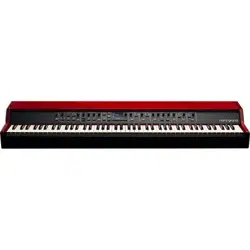Loading ...
Loading ...
Loading ...

3. GETTING STARTED | 9
LIVE MODE
The five Live programs differ from other programs in that all edits made
to them are instantly stored, without the need for a manual Store
operation.
1 Press LIVE MODE and use the PROGRAM buttons to navigate the
five Live programs.
2 Make an edit, such as activating one of the effects sections, to one
of the programs.
3 Select a different Live program and then return to the one that was
edited. Note that the edit was automatically stored.
4 Press the Live Mode button again to exit Live Mode and return to
the Program banks.
If Live Mode is active and you wish to store the settings permanently
as a program in one of the Program banks, you can do so using the
standard Store methods (see above). Conversely, programs can also
be stored into any of the Live Mode memory locations by pressing LIVE
MODE and selecting one of the Live program locations.
ACTIVATE EFFECTS
1 Make sure the first program (or any piano based program) is
selected.
2 Activate the reverb by pressing the Reverb ON button.
3 Adjust the DRY/WET balance with the knob above the reverb
selector.
4 Activate the delay effect by pressing the DELAY ON/OFF button.
5 The LEDs above the button indicate which sound engine is routed
to the effect; PIANO or SYNTH. Press SHIFT and the Delay SOURCE
button so that the PIANO LED is lit, if it is not already.
“Double-tapping” the On Off / Source button is a shortcut for
quickly changing the source for any effects unit.
6 Try the TEMPO, FEEDBACK and DRY/WET controls, to alter the char-
acter and intensity of the Delay effect.
LAYER WITH SAMPLE SYNTH
1 Turn ON the Sample Synth section.
2 Use the two CATEGORY buttons to select the Strings Ensemble
category (the categories are alphabetically sorted).
Pressing down both Category buttons simultaneously presents a
list of all available categories. The desired category can then quickly
be identified and selected using the Sample Select dial.
3 Turn the SAMPLE SELECT dial and select a string sound from the
selected category. The name of the sample is shown at the bottom
of the display.
4 Use the LEVEL control to set an appropriate sound level for the
strings.
When a sample is selected, preset settings for the Sample Synth enve-
lope (Attack, Decay/Sustain/Release), Dynamics and Filter settings are
also loaded. These parameters can subsequently be adjusted manually
as desired. Descriptions of these controls are found in the Sample Synth
reference chapter, starting on page 13.
CREATE A SPLIT
1 Make sure that the Piano and Sample Synth sections are both
turned on.
2 Press the KBD SPLIT button. There are two configurations to
choose from: PNO/SYNT and SYNT/PNO. In this case set it to Pno/
Synt. This means that the Piano sound is placed at the left side of
the keyboard and the Sample Synth sound to the right.
3 To adjust the position of the Split point press SET SPLIT (Shift +
KBD Split button.
4 Make sure that the Pos setting is focused by pressing the Pos soft
button, corresponding to the Program 1 button. Set the split point
to C4 using the dial.
The keyboard is now divided into two zones, the split point being
indicated with a LED above the keyboard. Feel free to use the OCTAVE
UP/DOWN controls in the Piano and Sample Synth section for accessing
different ranges of the respective sounds.
SET UP A SPLIT CROSS-FADE (SPLIT WIDTH)
As a final step, let’s adjust the split point so that the split Piano and
Sample Synth sounds will transition gradually between one another:
5 Again, press SET SPLIT (Shift + KBD Split).
6 Press the Width soft button (Program 2 button). The Split width for
each split point can now be adjusted.
7 Set the width value to 12 by turning the dial. Let go of the KBD
SPLIT button.
Playing across the Split point will now “cross-fade” between the lower
and the upper sounds. Note that the split LED above the keyboard is lit
with a red light, indicating that width is set to 12. When width is set to 6
the LED is yellow and with width set to 1 the LED is green.
TURN ON PANEL LOCK
The PANEL LOCK function is found at the far left of the
panel and when engaged will protect the buttons from
unwanted interaction. Here is how to turn it On and Off:
1 Press down the Panel Lock button for one second, so that its LED
lights up.
2 Try a few buttons on the panel. Notice that they have no effect and
that the display reads “Panel Locked”.
3 Press down the Panel Lock button again for one second, to turn
the feature off.
The Program 1-5 and Live buttons can still be used, but require
being pressed down for one second in order to have effect. Knobs
and dials on the panel can be used as normal, even when Panel
Lock is active.
KEYBOARD SPLIT
Split Position
C4 1
WidthPos
Loading ...
Loading ...
Loading ...
